I'm writing a package that extends ggplot2. One of those extensions is a geom_arrow() that takes aesthetics mag and angle to plot vector fields by magnitude and direction. I also created a scale_mag() to manipulate the length of the arrows with the prospect of creating also a new guide. Right now both geom and scale work as expected when added together.
ggplot(geo, aes(lon, lat)) +
geom_arrow(aes(mag = mag, angle = angle)) +
scale_mag()

But if I don't add scale_mag(), it doesn't work at all. What I want is for this scale to work like scale_color(), which is added by default when the color aesthetic is present.
Here is the code as it is right now:
geom_arrow <- function(mapping = NULL, data = NULL,
stat = "arrow",
position = "identity", ...,
start = 0,
direction = 1,
# scale = 1,
min.mag = 0,
skip = 0,
skip.x = skip,
skip.y = skip,
arrow.angle = 15,
arrow.length = 0.5,
arrow.ends = "last",
arrow.type = "closed",
arrow = grid::arrow(arrow.angle, unit(arrow.length, "lines"),
ends = arrow.ends, type = arrow.type),
lineend = "butt",
na.rm = FALSE,
show.legend = NA,
inherit.aes = TRUE) {
layer(geom = GeomArrow,
mapping = mapping,
data = data,
stat = stat,
position = position,
show.legend = show.legend,
inherit.aes = inherit.aes,
params = list(
start = start,
direction = direction,
arrow = arrow,
lineend = lineend,
na.rm = na.rm,
# scale = scale,
skip.x = skip.x,
skip.y = skip.y,
min.mag = min.mag,
...)
)
}
GeomArrow <- ggplot2::ggproto("GeomArrow", Geom,
required_aes = c("x", "y"),
default_aes = ggplot2::aes(color = "black", size = 0.5, min.mag = 0,
linetype = 1, alpha = NA),
draw_key = ggplot2::draw_key_path,
draw_panel = function(data, panel_scales, coord,
arrow = arrow, lineend = lineend,
start = start, direction = direction,
preserve.dir = TRUE) {
coords <- coord$transform(data, panel_scales)
unit.delta <- "snpc"
if (preserve.dir == FALSE) {
coords$angle <- with(coords, atan2(yend - y, xend - x)*180/pi)
unit.delta <- "npc"
}
coords$dx <- with(coords, mag*cos(angle*pi/180))
coords$dy <- with(coords, mag*sin(angle*pi/180))
# from https://stackoverflow.com/questions/47814998/how-to-make-segments-that-preserve-angles-in-different-aspect-ratios-in-ggplot2
xx <- grid::unit.c(grid::unit(coords$x, "npc"),
grid::unit(coords$x, "npc") + grid::unit(coords$dx, unit.delta))
yy <- grid::unit.c(grid::unit(coords$y, "npc"),
grid::unit(coords$y, "npc") + grid::unit(coords$dy, unit.delta))
mag <- with(coords, mag/max(mag, na.rm = T))
arrow$length <- unit(as.numeric(arrow$length)*mag, attr(arrow$length, "unit"))
pol <- grid::polylineGrob(x = xx, y = yy,
default.units = "npc",
arrow = arrow,
gp = grid::gpar(col = coords$colour,
fill = scales::alpha(coords$colour, coords$alpha),
alpha = ifelse(is.na(coords$alpha), 1, coords$alpha),
lwd = coords$size*.pt,
lty = coords$linetype,
lineend = lineend),
id = rep(seq(nrow(coords)), 2))
pol
})
StatArrow <- ggplot2::ggproto("StatArrow", ggplot2::Stat,
required_aes = c("x", "y"),
default_aes = ggplot2::aes(min.mag = 0, dx = NULL, dy = NULL,
mag = NULL, angle = NULL),
compute_group = function(data, scales,
skip.x = skip.x, skip.y = skip.y,
min.mag = min.mag) {
min.mag <- data$min.mag %||% min.mag
if (is.null(data$mag) | is.null(data$angle)) {
if (is.null(data$dx) | is.null(data$dy)) stop("stat_arrow need dx, dy or mag angle (improve mesage!!)")
data$mag <- with(data, Mag(dx, dy))
data$angle <- with(data, atan2(dy, dx)*180/pi)
} else {
data$dx <- with(data, mag*cos(angle*pi/180))
data$dy <- with(data, mag*sin(angle*pi/180))
}
data <- subset(data, x %in% JumpBy(unique(x), skip.x + 1) &
y %in% JumpBy(unique(y), skip.y + 1) &
mag >= min.mag)
data$xend = with(data, x + dx)
data$yend = with(data, y + dy)
data
}
)
scale_mag <- function(length = 0.1,
max = waiver(),
default_unit = "lines") {
# if (!is.unit(length)) length <- ggplot2::unit(length, default_unit)
continuous_scale("mag",
"mag",
identity,
rescaler = rescale_mag(length, max),
guide = "none")
}
# scale_type.mag <- function(x) "vector"
rescale_mag <- function(length, max) {
function(x, from) {
if (is.waive(max)) max <- max(x, na.rm = T)
scales::rescale(x, c(0, length), c(0, max))
}
}